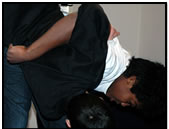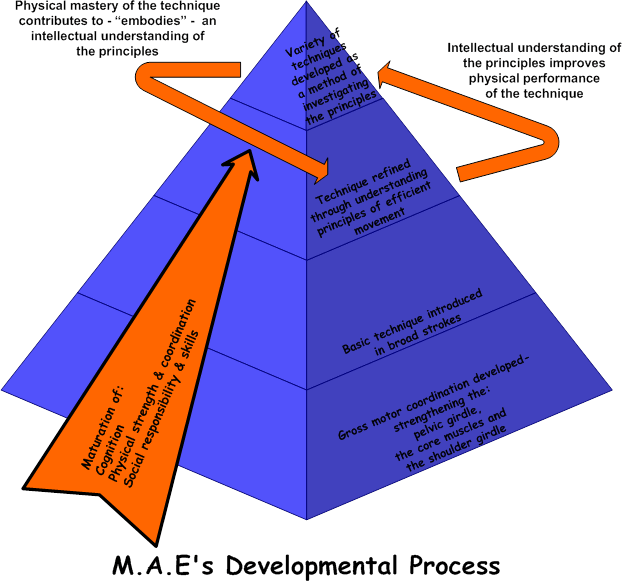|
|
|
Martial Arts as Physical Education for Montessori
M.A.E can be described in the light of the core Montessori concepts:
1 Respect as the basis for social skills
One of Judo’s most famous mottos, which we adopt is "Training for mutual welfare and benefit". Unless both partners enjoy training and benefit from it,
Training is a physical metaphor for a range of essential understandings. The “body” provides us with our most intense experiences and therefore what is understood by and through the body - “body wisdom” – is very deeply absorbed..
For example, if a student understands leverage through applying a lock or hold
So if a student learns to physically cooperate with a partner so both can master a technique, that understanding of cooperation is at a very deep level and with time likely to permeate all aspects of her/ his life.
2 Confidence
All children develop and experience exciting new physical skills. This process is a tangible experience and not dependent on external affirmations such as grading to a new coloured belt or winning a competition. We have found that this tangible experience of progress develops a remarkable and genuine
Instilling confidence in students is a primary objective of our teaching and there is great emphasis on positive feedback - “Encouragement and enthusiasm” is our teaching mantra.
3 Own discoveries through independent play
Thereafter, partners are given the space to focus on and master this new aspect. Each student develops a unique knowledge to share with his/ her partner. This dynamic, social and interactive way of training ensures that repetition does not degenerate into mindless drilling.
We are able to create this atmospher because we understand technique is a vehicle for principles of movement to be understood. These principles can then be applied to a range of techniques or any other physical activity.
4 Own drive to enquire
We often find students come to their teacher bursting with excitement, proudly showing something that they have discovered and achieved.
This method of teaching strongly encourages a proactive rather than passive approach to learning. Each student acquires a personal understanding of a technique and learns from everyone they train with.
5 Mixed ages
. Advanced and older students learn how to communicate, l
Even young students take on board the responsibilities of being ‘senior’ as more important than developing physical technique.
Teaching is the best way of learning so seniors, working on sharing their knowledge develop at an accelerated rate whilst junior students train in a supportive environment and too develop remarkably quickly.
6 Physical – large motor movements
The M.A.E syllabus has exercises that specifically develop the muscle groups
|




 We offer a system of physical education based on Ju Jitsu (the forerunner of Judo) and Fanchento. We do not teach the self defence or sport aspect of martial art to children.
We offer a system of physical education based on Ju Jitsu (the forerunner of Judo) and Fanchento. We do not teach the self defence or sport aspect of martial art to children. Jigoro Kano, the Ju Jitsu master who fathered Judo was by profession an educator and Judo was intended as a method of physical and moral education. He placed an enormous emphasis on Respect or “Rei” as the foundation of martial art training.
Jigoro Kano, the Ju Jitsu master who fathered Judo was by profession an educator and Judo was intended as a method of physical and moral education. He placed an enormous emphasis on Respect or “Rei” as the foundation of martial art training.  both are unlikely to develop to any significant degree. So, far from encouraging a competitive attitude, true martial art (Budo) encourages cooperation.
both are unlikely to develop to any significant degree. So, far from encouraging a competitive attitude, true martial art (Budo) encourages cooperation. , or learns the consequence of momentum through repeated practise of a Judo throw, his/ her understanding of these concepts, because experienced physically, and so is of a much deeper nature than a purely academic understanding.
, or learns the consequence of momentum through repeated practise of a Judo throw, his/ her understanding of these concepts, because experienced physically, and so is of a much deeper nature than a purely academic understanding. Developing confidence is our primary concern, because as soon as children are confident their skills increase at a remarkable rate.
Developing confidence is our primary concern, because as soon as children are confident their skills increase at a remarkable rate.  confidence.
confidence.  In classes, a movement or technique is often repeatedly practised with a partner. Only when a pair has already begun discovering or unconsciously implementing a new facet of the movement, then it is explicitly explained.
In classes, a movement or technique is often repeatedly practised with a partner. Only when a pair has already begun discovering or unconsciously implementing a new facet of the movement, then it is explicitly explained. 
 By encouraging in the physical sphere a process of investigation and giving recognition to discoveries we ignite a passion for learning.
By encouraging in the physical sphere a process of investigation and giving recognition to discoveries we ignite a passion for learning. 



 Traditionally martial art is practised in a class of mixed ages and abilities- and some of the most respected teachers regard this as a fundamental aspect of training.
Traditionally martial art is practised in a class of mixed ages and abilities- and some of the most respected teachers regard this as a fundamental aspect of training. ead and work gently with younger and less experienced students.
ead and work gently with younger and less experienced students. 
 fundamental to gross coordination - the pelvic girdle, the shoulder girdle and the core muscles.
fundamental to gross coordination - the pelvic girdle, the shoulder girdle and the core muscles. 
